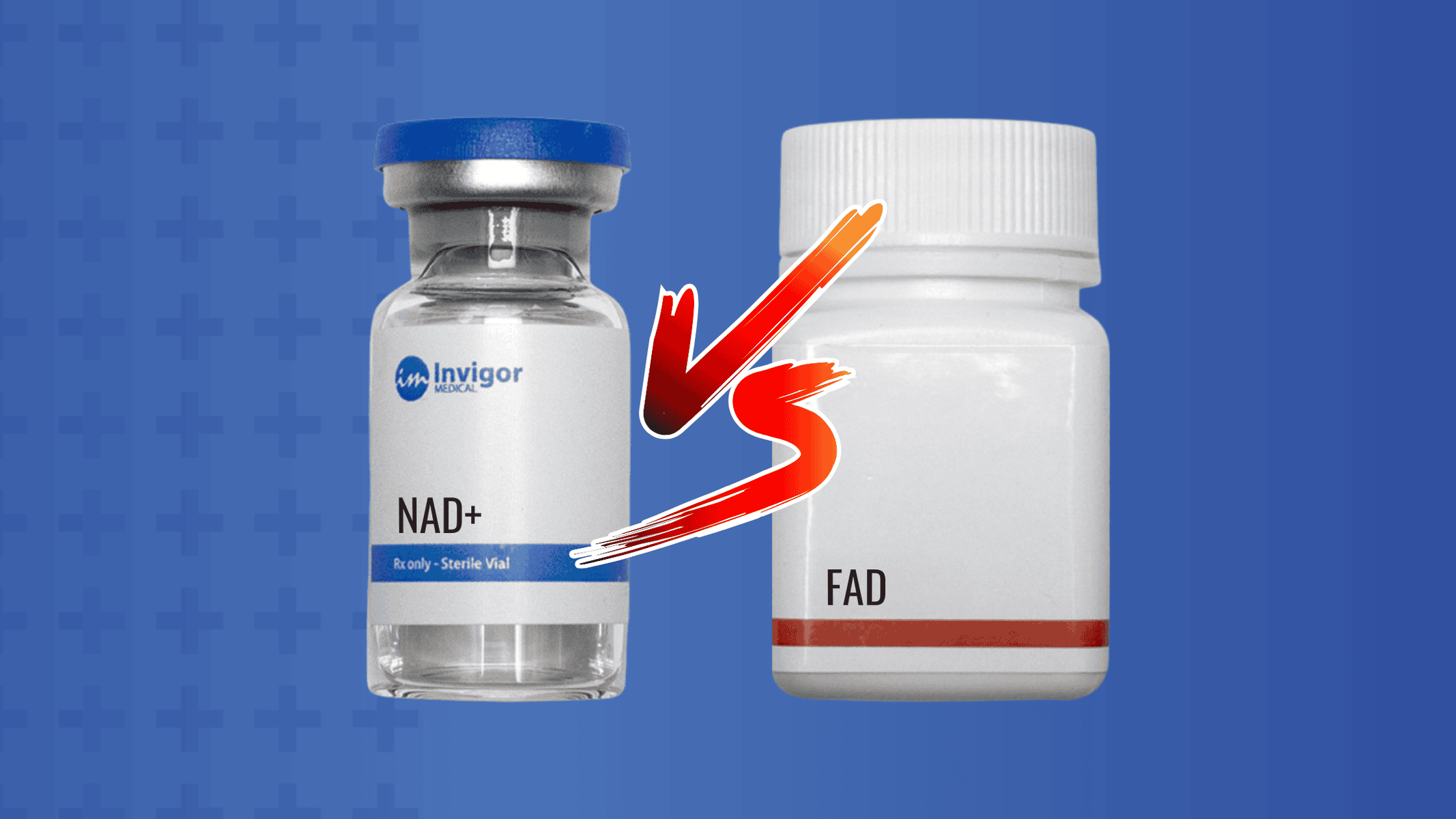NAD+ vs FAD—two essential coenzymes that play a key role in energy production and cellular health. If you’re looking to boost your energy levels, support anti-aging efforts, or enhance metabolic function, understanding the differences between these two can help you make the best choice. While both contribute to overall vitality, factors like effectiveness, dosing, and safety can set them apart. In this guide, we’ll break down how NAD+ and FAD work, compare their benefits, and help you determine which one aligns with your health goals. Let’s dive in!

Medical Applications of NAD+ vs. FAD in Treatment and Recovery
What it Treats
- Supports cognitive function and neuroprotection (e.g., Alzheimer’s, Parkinson’s)
- Aids in energy metabolism and reduces fatigue
- Helps manage age-related decline and longevity support
- Assists in addiction recovery and withdrawal symptoms
- Supports muscle recovery and athletic performance
- Supports metabolic disorders, including mitochondrial dysfunction
- Helps manage oxidative stress and inflammation
- Aids in the treatment of riboflavin deficiency disorders
- Supports vision health (e.g., cataracts, retinal degeneration)
- Plays a role in managing certain neurological conditions like migraines
How it Works
Main Benefits
- Boosts Cellular Energy Production: Enhances mitochondrial function to support sustained energy levels and combat fatigue.
- Supports Brain Function: Improves cognitive clarity, memory retention, and neurological health by promoting cellular repair.
- Enhances DNA Repair: Aids in maintaining genetic stability, reducing oxidative stress, and slowing age-related cellular decline.
- Reduces Inflammation: Helps regulate immune responses to lower chronic inflammation and promote long-term wellness.
- Supports Metabolic Health: Improves insulin sensitivity and helps regulate metabolic processes for better weight and glucose control.
- Aids in Energy Metabolism: Promotes the breakdown of carbohydrates, fats, and proteins to sustain bodily energy needs.
- Supports Antioxidant Defense: Helps neutralize free radicals and protect cells from oxidative damage.
- Promotes Red Blood Cell Formation: Plays a key role in maintaining healthy oxygen transport and reducing anemia risk.
- Enhances Nervous System Function: Supports neurotransmitter production for balanced mood and cognitive stability.
- Supports Skin and Eye Health: Contributes to tissue repair, reducing dryness, irritation, and age-related degeneration.
Comparing NAD+ and FAD: Differences, Benefits, and Best Uses
Dosing Requirements
- Method of Administration: NAD+ is typically administered via intravenous (IV) infusion, subcutaneous injection, or oral supplements.
- Typical Dosage: IV infusions commonly range from 250 mg to 750 mg per session, while oral supplements may provide 300–600 mg daily.
- Optimal Timing: NAD+ infusions are often given in the morning or early afternoon to support energy production, while oral supplements are best taken with food.
- Safe Combinations: NAD+ pairs well with glutathione injections for enhanced detoxification and B-complex vitamins to support cellular metabolism.
- Method of Administration: FAD is primarily taken as an oral supplement but can also be included in IV therapy formulations.
- Typical Dosage: A standard daily dosage of FAD supplements ranges from 10 mg to 50 mg, depending on individual needs.
- Optimal Timing: FAD is best taken in the morning with food to optimize absorption and support energy metabolism throughout the day.
- Safe Combinations: FAD can be safely combined with CoQ10 supplements for mitochondrial support and NMN for increased cellular energy production.
Effect Duration
- Onset Time: NAD+ supplementation typically begins working within 30 to 60 minutes, depending on the delivery method (e.g., IV vs. oral).
- Duration of Effects: The therapeutic effects of NAD+ last between 4 to 8 hours after administration, with IV forms providing longer-lasting benefits.
- Immediate vs. Cumulative Effects: Some effects, like increased energy and mental clarity, may be noticed immediately, but long-term benefits (e.g., improved cellular repair and anti-aging effects) accumulate over weeks to months.
- When to Expect Noticeable Results: Many patients report noticeable improvements in cognitive function and energy levels within the first few doses, with more substantial results seen after consistent use over several weeks.
- Onset Time: FAD generally starts working within 60 to 90 minutes, as it must be converted into its active form to exert effects.
- Duration of Effects: The benefits of FAD last approximately 6 to 12 hours, depending on individual metabolism and dosage.
- Immediate vs. Cumulative Effects: Some users experience an initial boost in energy and metabolism, but full cellular and enzymatic support effects develop gradually with continued use.
- When to Expect Noticeable Results: Most users begin to notice enhanced metabolic and mitochondrial function within a few days, with more pronounced improvements appearing after several weeks of supplementation.
Comparing the Safety and Side Effects of NAD+ and FAD Supplements
Side Effects and Safety
Common Side Effects (Mild to Moderate):
- Mild headache
- Nausea
- Flushing sensation
Rare but Serious Side Effects (Moderate to Severe):
- Dizziness or lightheadedness
- Increased heart rate
- Allergic reaction (itching, swelling)
Safety Summary: NAD+ supplements and IV infusions are generally well-tolerated, with most side effects being mild and temporary. However, high doses may cause discomfort, particularly flushing and nausea.
When to Seek Medical Attention: Immediate medical help is necessary if severe dizziness, rapid heartbeat, or signs of an allergic reaction occur.
Drug Interactions: Potential interactions with blood pressure medications and certain metabolic enhancers should be considered before use.
Common Side Effects (Mild to Moderate):
- Mild gastrointestinal discomfort
- Fatigue
- Dry mouth
Rare but Serious Side Effects (Moderate to Severe):
- Difficulty breathing
- Severe abdominal pain
- Muscle weakness
Safety Summary: FAD supplementation is generally safe, with most adverse effects being short-term and mild. Long-term risks are minimal when recommended dosages are followed.
When to Seek Medical Attention: Seek medical care if experiencing severe abdominal pain, difficulty breathing, or persistent muscle weakness.
Drug Interactions: May interact with medications affecting mitochondrial function or metabolic pathways; consult a healthcare provider before combining.
Ideal Candidates for NAD+ vs. FAD: Choosing the Right Coenzyme for Your Health Needs
Ideal Candidate
NAD+ is best suited for individuals looking to enhance cellular energy production, support brain function, and promote healthy aging.
- Adults over 30 experiencing fatigue, brain fog, or decreased energy levels
- Individuals managing age-related cognitive decline or neurodegenerative conditions
- Those recovering from metabolic stress, chronic inflammation, or prolonged illness
FAD is ideal for individuals needing robust enzymatic support for metabolism and oxidative stress regulation.
- People with metabolic disorders requiring enhanced energy conversion and nutrient processing
- Individuals with chronic oxidative stress or mitochondrial dysfunction seeking additional cellular protection
- Athletes or highly active individuals needing optimized enzymatic activity for endurance and muscle recovery
Why NAD+ Is the Superior Choice for Cellular Health
NAD+ stands out due to its superior role in cellular energy production and DNA repair. While FAD supports enzymatic reactions, NAD+ offers enhanced metabolic and neurological benefits. Given its broader impact on aging, energy metabolism, and cognitive function, NAD+ emerges as the preferred choice for most patients seeking optimal cellular health.



